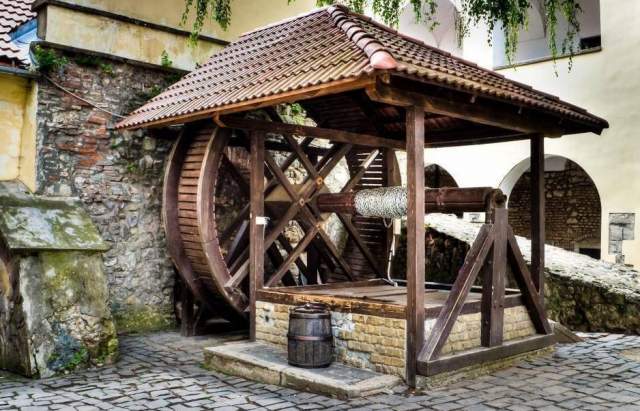The medieval castle of Palanok is the main attraction of ancient Mukachevo. Hundreds of thousands of travelers from all over the world come here every year to witness this unique example of the architecture of forts and castles, recognized as one of the most interesting and well-preserved defense complexes in Ukraine. The total area of the castle is 14 thousand square meters. The castle consists of 130 different rooms with a complex system of underground passages connecting them. The castle now houses a museum dedicated to the history of Mukachevo and the castle.
Kyiv. Ukraine. Ukraine Gate – April 29, 2021 – Tourism and Travel
It is believed that Mukachevo Castle was built in the times of Kievan Rus’. Then they were wooden barriers (“Palanca” – meaning in Italian “barrier”) or wooden fortifications, hence the name.
Palanok Castle became a stone at the end of the fourteenth century, owned by Podolsk Prince Fedor Koriatovich, who greatly rebuilt and renovated its defense complex. New walls have been built, a deep pit dug, additional towers have been erected, and homes have been built. It was later connected by long, narrow passages, one of which was called the trap, or death lane. If the enemy enters the city and enters this corridor, the entrance and exit are closed with a metal gate, and boiling water and hot tar are poured on the captured enemy through holes in the roof.

Since the sixteenth century, Austria and Transylvania fought continuously for Palandock Castle, as a result of which its owners often changed hands. In 1633, the building transferred to the ownership of the Transylvanian Prince Dyerd Rakocchi, who transformed the Mukachevo Castle into the center of his principality. During his reign, the fortifications were actively renewed and rebuilt. The old castle was rebuilt, and two new ones were built near it, the middle and the lower ones.
After the death of the prince, his widow, Sofia Batori, assumed power. During her reign, two defensive runways and an external defensive ring were built. By the way, Princess Sophia was one of the brightest rulers of Palanok and was famous for her extraordinary cruelty, as she is said to have drunk human blood and bathed in it to find eternal youth.
The history of Mukachevo Castle is associated with the name of another woman Ilona Zarni, daughter-in-law of Sofia Baturi. Unlike her mother-in-law, she was known for her extraordinary bravery in repelling the Austrian forces’ attack on the castle. The siege lasted for 2.5 years, and Ilona Zarni was always the garrison of the castle. However, the enemy captured the fortress, and the Austrians forced Ilona Zarni to sign a document of surrender.
At the end of the eighteenth century, Palanok Castle lost its strategic importance. And soon the political prison of the Austrian monarchy was opened in it. Where it remained for just over 100 years, then the castle was abandoned for a long time.
History of Mukachevo Castle
Since 1989, the castle is occupied by the Mukachevo Historical Museum, which presents more than 10 interesting exhibits. There is also an art gallery featuring the best paintings by Western Ukrainian painters and ancient icons. Some Palanok halls are dedicated to the exhibition “Wooden Churches of Transcarpathia” and an art salon, where you can buy paintings and souvenirs from local artists. The castle also contains cozy cafes where you can enjoy a cup of aromatic coffee and admire the views of the castle.
After World War I, when Carpathian Russia was annexed to Czechoslovakia under the Treaty of Trianon, the castle was first used by the Czechoslovak Army (1919-1938) and then by the Royal Hungarian Army Barracks 1939-1944 as barracks for the Soviet Army. Between 1962 and 1973, the Industrial High School used it to train agricultural machinery (tractor) operators.
And in the period from 1971 to 1993, the Lviv Restoration Institute worked in the castle. It is claimed that the castle was damaged during this period of more than several centuries of siege. The ruined castle has recently undergone a “real” repair, and there are many exhibits in the restored rooms. The Mukachevo History Museum is located here. One of the highlights of the event was the Mankashi Gallery, which was held at the castle in 2007, where most of the painter’s works were exhibited.
Legend of Palanok Castle

It is known that the deepest well in Transcarpathia is located in the territory of Palanok Castle at a depth of 85 meters. Prince Fyodor Koriatovich ordered a well to be drilled in the castle square. It had been excavated for a long and painful time, but the water had not yet appeared. Then Satan came to the owner of the castle and offered water in the well in exchange for a bag of gold. The prince found himself in a difficult situation and decided to use a trick: the demon had given the smallest a bag of two coins. Upset, the demon grabbed the money and jumped into the well. It is said that his humiliating howl can still be heard from there.
The well may have an exit to the Latorica River. During the long siege, the defenders of the fortress maintained communication through it with the outside. And there are rumors that someone left a duck in the well that fell there.
Read also:
Source: Ukrgate







